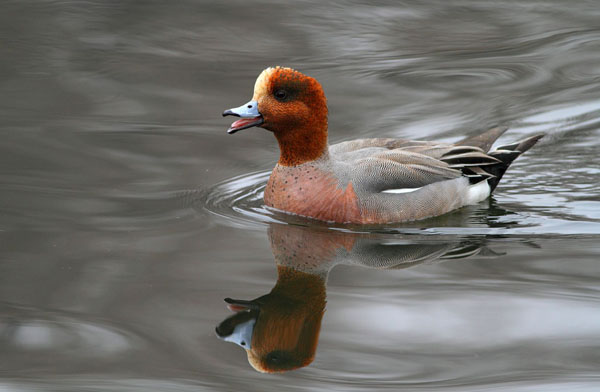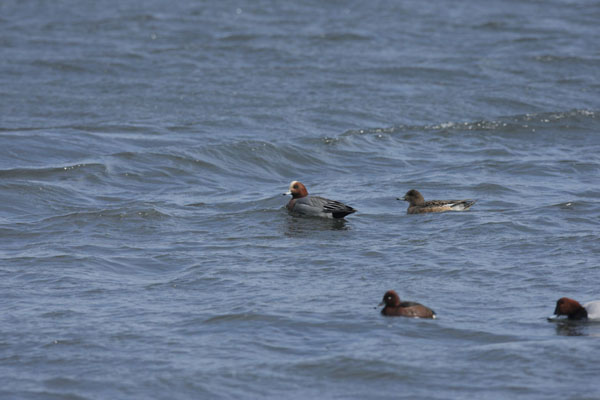Anas penelope
IUCN
LCBasic Information
Scientific classification
- name:Anas penelope
- Scientific Name:Anas penelope,Eurasian Wigeon,European Wigeon,Wigeon,Crane duck, Red duck, Red necked duck, goose duck, sacrificial duck
- Outline:Waterfowl
- Family:Anseriformes Anseriidae
Vital signs
- length:41-52cm
- Weight:About 0.6 kg
- lifetime:19years
Feature
The male bird has a brown-red head and neck, while the female bird has a dark brown head and nape.
Distribution and Habitat
China breeds in the northeast and overwinters in the Yellow River and waters south of it, including Taiwan and Hainan Island. It breeds throughout the Palaearctic and winters in the southern part of the range.
It likes to live in open waters rich in aquatic plants such as rivers, lakes, ponds, estuaries, bays, swamps, etc. It often flocks during non-breeding period, and also mixes with other river ducks. It often makes melodious whistling noises during non-breeding period
Appearance
The male bird has a chestnut red head and neck with bright yellow crown feathers, a pink breast, a black undertail cover, a milky white underbelly, and the rest of the body feathers, with large gray wings and white spots, and a green wing mirror. The female has a brown body, reddish brown flanks, white underbelly and grayish brown wing mirrors. Iris dark brown, beak lead gray, feet black.
Details
Red-necked ducks are medium-sized ducks, smaller than domestic ducks and about the same size as ribbed ducks. They often move in groups and mix with other ducks except during breeding periods. Good at swimming and diving. Happy often put the tail up, head bent to the chest. The flight is fast and powerful. When there is danger, it can rush directly from the water or the ground, and make a call, loud and crisp. The male of the red-necked duck makes a pleasant whistle whe-oo, and the female is a short duck call.

It feeds mainly on plant foods. They often gather in groups near water to forage for the roots, stems, leaves, and fruits of seagrasses, algae, and other aquatic plants. They often forage for grass, weed seeds, and crops on shore or in fields, and also eat small amounts of animal food.
From the end of March to the beginning of April every year, it moves from the south to North China and the south of Northeast China, and reaches the north of Northeast China in mid-late April, some of which stay to breed, and some continue to move north. At the end of September and the beginning of October, a large number of individuals migrated from the northern breeding ground to the southern part of Northeast China and North China, and gradually migrated south until the beginning of November, some individuals were still seen staying in Northeast China and North China. Migrating in groups, often flying in a line and very fast.
Pairs are usually formed during the winter and start nesting soon after arriving at the breeding ground. Breeding season May to July. They usually nest in grass or bushes on the ground in small lakes, ponds, and rivers that are rich in aquatic plants or where shrubs and plants grow along the shore. The nests are generally not far from the water, but some are as far as 100-200 meters from the water's edge. The nest is very simple, more than a 5-7 cm deep pit on the ground, put a little dead grass, sometimes without any inner cushion, but the nest is often surrounded by a large number of feathers, and it is used to cover the eggs when leaving the nest. Each clutch lays 7-11 eggs, generally 8-9 eggs, 1 egg produced 1 day, white or milky white, smooth without spots, the size of 50-60 mm ×33-41 mm, weight 41-47 grams. Incubation begins after the first egg is laid, and the incubation period is 22-25 days, which is borne by the female. The chicks are young and can fly after 40 to 45 days under the lead of the female after hatching. The young are sexually mature at age 1.

The red-necked duck is one of the more common wild ducks in winter in China. According to the latest survey data in 1992, the number of overwintering populations in China was 48,348. The population of the red-necked duck is also relatively abundant in the world. According to statistics in Europe and the Mediterranean and Black Sea regions in 1975, the population is in the millions. According to the 1992 survey of Asian midwinter waterbirds organized by the International Waterfowl Research Bureau, there were 39,446 in West Asia, 143,152 in South Asia, 69,652 in East Asia, and 307 in Southwest Asia. Asia's total of 251,557 individuals is less abundant than Europe's, and significantly lower than the 320,676 individuals counted in 1990, mainly due to hunting. Population management should be strengthened.








